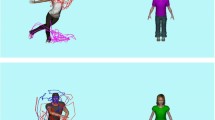Abstract
Using a conditional discrimination procedure, pigeons were exposed to a nonverbal analogue of qualifying autoclitics such as definitely and maybe. It has been suggested that these autoclitics are similar to tacts except that they are under the control of private discriminative stimuli. Instead of the conventional assumption of privacy, which precludes direct manipulation of the controlling variable, the autoclitic was here identified as a response that is jointly determined by its function as a modifier for the consequence of the tact and by some variable that modifies stimulus control of the tact. Following this modified conceptualization, a novel conditional discrimination procedure was developed as an analogue for establishing autoclitic-like behavior in pigeons. Under some conditions, autoclitic-like behavior was established. Methodological challenges in developing an autoclitic analogue in nonhumans are discussed, followed by a consideration of the implications of such analogues for the understanding of verbal and, more broadly, human behavior.



Similar content being viewed by others
References
Baum, W. M. (1993). The status of private events in behavior analysis. Behavioral and Brain Sciences, 16, 644.
Baum, W. M. (2011). Behaviorism, private events, and the molar view of behavior. Behavior Analyst, 34, 185–200.
Berryman, R., Cumming, W. W., & Nevin, J. A. (1963). Acquisition of delayed matching in the pigeon. Journal of the Experimental Analysis of Behavior, 6, 101–107.
Bonem, M., & Crossman, E. K. (1988). Elucidating the effects of reinforcement magnitude. Psychological Bulletin, 104, 348–362.
Catania, A. C. (1963). Concurrent performances: a baseline for the study of reinforcement magnitude. Journal of the Experimental Analysis of Behavior, 6, 299–300.
Catania, A. C. (1980). Autoclitic processes and the structure of behavior. Behaviorism, 8, 175–186.
Catania, A. C. (1998). Learning (4th ed.). Upper Saddle River: Prentice Hall.
Catania, A. C., Matthews, B. A., & Shimoff, E. (1982). Instructed versus shaped human verbal behavior: interactions with nonverbal responding. Journal of the Experimental Analysis of Behavior, 38, 233–248.
Chomsky, N. (1957). Syntactic structures. The Hague: Mouton.
Chomsky, N. (1959). A review of B.F. Skinner’s verbal behavior. Language, 35, 26–58.
Galizio, M. (1979). Contingency-shaped and rule-governed behavior: instructional control of human loss avoidance. Journal of the Experimental Analysis of Behavior, 31, 53–70.
Grace, R. C. (1995). Independence of reinforcement delay and magnitude in concurrent chains. Journal of the Experimental Analysis of Behavior, 63, 255–276.
Horne, P. J., & Lowe, C. F. (1993). Determinants of human performance on concurrent schedules. Journal of the Experimental Analysis of Behavior, 59, 29–60.
Howard, J. S., & Rice, D. E. (1988). Establishing a generalized autoclitic repertoire in preschool children. The Analysis of Verbal Behavior, 6, 45–59.
Inman, A., & Shettleworth, S. J. (1999). Detecting metamemory in nonverbal subjects: a test with pigeons. Journal of Experimental Psychology: Animal Behavior Processes, 25, 389–395.
Lowe, C. F. (1979). Determinants of human operant behaviour. In M. D. Zeiler & P. Harzem (Eds.), Advances in analysis of behaviour (Vol. 1). Reinforcement and the organisation of behavior (pp. 159–192). Chichester: Wiley.
Lowe, C. F., Beasty, A., & Bentall, R. P. (1983). The role of verbal behavior in human learning: infant performance on fixed-interval schedules. Journal of the Experimental Analysis of Behavior, 39, 157–164.
Madden, G. J., & Perone, M. (1999). Human sensitivity to concurrent schedules of reinforcement: effects of observing schedule-correlated stimuli. Journal of the Experimental Analysis of Behavior, 71, 303–318.
Matthews, B. A., Shimoff, E., Catania, C. A., & Sagvolden, T. (1977). Uninstructed human responding: sensitivity to ratio and interval contingencies. Journal of the Experimental Analysis of Behavior, 27, 453–467.
Rachlin, H., Raineri, A., & Cross, D. (1991). Subjective probability and delay. Journal of the Experimental Analysis of Behavior, 55, 233–244.
Skinner, B. F. (1945). The operational analysis of psychological terms. Psychological Review, 52, 270–277.
Skinner, B. F. (1992). Verbal behavior. Cambridge: B. F. Skinner Foundation. Original work published in 1957.
Smith, J. D., Schull, J., Strote, J., McGee, K., Egnor, R., & Erb, L. (1995). The uncertain response in the bottlenosed dolphin (Tursiops truncates). Journal of Experimental Psychology: General, 124, 391–408.
Weiner, H. (1969). Controlling human fixed-interval performance. Journal of the Experimental Analysis of Behavior, 12, 349–373.
Zuriff, G. E. (1975). Where is the agent in behavior? Behaviorism, 3, 1–21.
Author information
Authors and Affiliations
Corresponding author
Additional information
The research was conducted under a protocol approved by the Animal Care and Use Committee at West Virginia University and was supported by a Student Research Grant from Verbal Behavior SIG to Toshikazu Kuroda. Portions of these data were presented at the 37th annual meeting of the Association for Behavior Analysis International, 2011, Denver, CO.
Rights and permissions
About this article
Cite this article
Kuroda, T., Lattal, K.A. & García-Penagos, A. An Analysis of an Autoclitic Analogue in Pigeons. Analysis Verbal Behav 30, 89–99 (2014). https://doi.org/10.1007/s40616-014-0019-6
Published:
Issue Date:
DOI: https://doi.org/10.1007/s40616-014-0019-6




